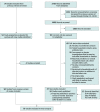Factors Associated With Household Transmission of SARS-CoV-2: An Updated Systematic Review and Meta-analysis
- PMID: 34448865
- PMCID: PMC8397928
- DOI: 10.1001/jamanetworkopen.2021.22240
Factors Associated With Household Transmission of SARS-CoV-2: An Updated Systematic Review and Meta-analysis
Abstract
Importance: A previous systematic review and meta-analysis of household transmission of SARS-CoV-2 that summarized 54 published studies through October 19, 2020, found an overall secondary attack rate (SAR) of 16.6% (95% CI, 14.0%-19.3%). However, the understanding of household secondary attack rates for SARS-CoV-2 is still evolving, and updated analysis is needed.
Objective: To use newly published data to further the understanding of SARS-CoV-2 transmission in the household.
Data sources: PubMed and reference lists of eligible articles were used to search for records published between October 20, 2020, and June 17, 2021. No restrictions on language, study design, time, or place of publication were applied. Studies published as preprints were included.
Study selection: Articles with original data that reported at least 2 of the following factors were included: number of household contacts with infection, total number of household contacts, and secondary attack rates among household contacts. Studies that reported household infection prevalence (which includes index cases), that tested contacts using antibody tests only, and that included populations overlapping with another included study were excluded. Search terms were SARS-CoV-2 or COVID-19 with secondary attack rate, household, close contacts, contact transmission, contact attack rate, or family transmission.
Data extraction and synthesis: Meta-analyses were performed using generalized linear mixed models to obtain SAR estimates and 95% CIs. The Preferred Reporting Items for Systematic Reviews and Meta-analyses (PRISMA) reporting guideline was followed.
Main outcomes and measures: Overall household SAR for SARS-CoV-2, SAR by covariates (contact age, sex, ethnicity, comorbidities, and relationship; index case age, sex, symptom status, presence of fever, and presence of cough; number of contacts; study location; and variant), and SAR by index case identification period.
Results: A total of 2722 records (2710 records from database searches and 12 records from the reference lists of eligible articles) published between October 20, 2020, and June 17, 2021, were identified. Of those, 93 full-text articles reporting household transmission of SARS-CoV-2 were assessed for eligibility, and 37 studies were included. These 37 new studies were combined with 50 of the 54 studies (published through October 19, 2020) from our previous review (4 studies from Wuhan, China, were excluded because their study populations overlapped with another recent study), resulting in a total of 87 studies representing 1 249 163 household contacts from 30 countries. The estimated household SAR for all 87 studies was 18.9% (95% CI, 16.2%-22.0%). Compared with studies from January to February 2020, the SAR for studies from July 2020 to March 2021 was higher (13.4% [95% CI, 10.7%-16.7%] vs 31.1% [95% CI, 22.6%-41.1%], respectively). Results from subgroup analyses were similar to those reported in a previous systematic review and meta-analysis; however, the SAR was higher to contacts with comorbidities (3 studies; 50.0% [95% CI, 41.4%-58.6%]) compared with previous findings, and the estimated household SAR for the B.1.1.7 (α) variant was 24.5% (3 studies; 95% CI, 10.9%-46.2%).
Conclusions and relevance: The findings of this study suggest that the household remains an important site of SARS-CoV-2 transmission, and recent studies have higher household SAR estimates compared with the earliest reports. More transmissible variants and vaccines may be associated with further changes.
Conflict of interest statement
Figures



References
-
- Areekal B, Vijayan SM, Suseela MS, et al. . Risk factors, epidemiological and clinical outcome of close contacts of COVID-19 cases in a tertiary hospital in southern India. J Clin Diagn Res .2021;15(3):34-37.
Publication types
MeSH terms
Grants and funding
LinkOut - more resources
Full Text Sources
Medical
Miscellaneous

